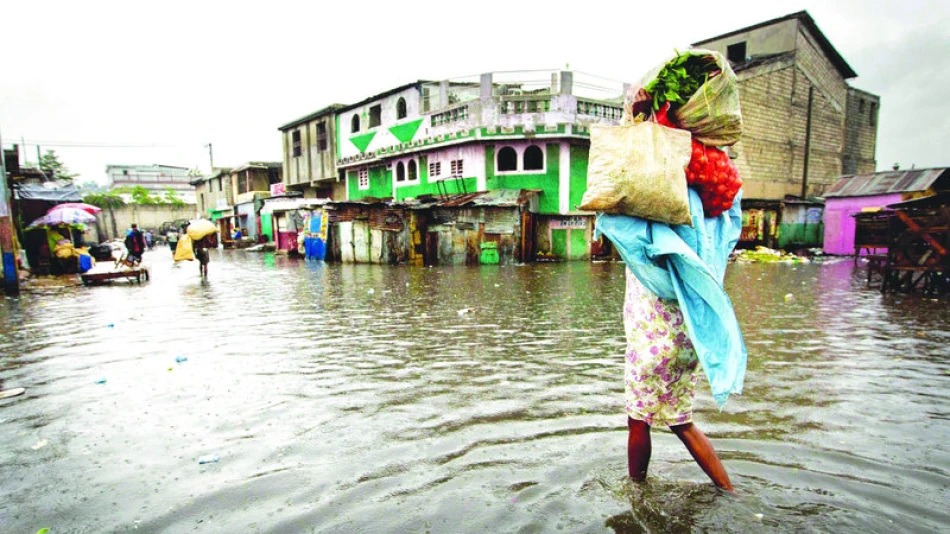
Latin America and the Caribbean Pay Heavy Price for Climate Change Impacts
Latin America's Climate Debt Trap: New Index Reveals Financial Vulnerability Crisis
A groundbreaking Columbia University index has exposed a devastating paradox: the Latin American and Caribbean nations most vulnerable to climate change are also drowning in debt, creating a vicious cycle that prevents them from adapting to environmental threats. Eight countries in the region now fall into a "high-risk zone" where climate vulnerability meets financial insecurity, affecting 105 million people across Venezuela, Haiti, Belize, Ecuador, El Salvador, Guatemala, Honduras, and Bolivia.
The Perfect Storm: Climate Risk Meets Financial Fragility
Latin America and the Caribbean rank as the world's second-most climate-vulnerable region after Africa, but geography alone doesn't explain their predicament. The new index, developed by Columbia University's National Center for Disaster Preparedness in partnership with the Center on Global Energy Policy and supported by the Rockefeller Foundation, combines three critical variables: climate threats, financial security, and governance quality across 188 countries.
Amy Campbell, a researcher at Columbia's disaster preparedness center, identifies the core problem: "Many of the countries most at risk from climate change are drowning in debt." Credit rating agencies repeatedly downgrade these nations due to their debt burdens, increasing their capital costs and trapping them in a cycle where adaptation becomes financially impossible.
The Worst-Hit Nations
Venezuela and Haiti top the vulnerability rankings, followed by a cluster of Central American nations that consistently appear as high-risk across all scenarios. The index projects outcomes for 2050 and 2080 under both optimistic and pessimistic scenarios, measuring progress against the Paris Agreement's goal of limiting global temperature rise to 2°C above pre-industrial levels, with efforts to keep it below 1.5°C.
Financial Vulnerability: The Hidden Climate Multiplier
The stark contrast between vulnerable and resilient nations becomes clear when comparing financial vulnerability scores. Venezuela scores 100 and Haiti 78 on financial vulnerability, while Chile—the region's best performer—scores just 41. Even on pure climate risk assessment, the gap is significant: Venezuela (67), Haiti (70), versus Chile (36).
Only 13 Latin American and Caribbean countries show low to moderate risk in the optimistic 2050 scenario. Guyana leads the region at 22nd globally, followed by Chile (51st), Mexico (60th), and Panama (64th). Larger economies like Brazil (88th), Colombia (100th), and Argentina (117th) fall closer to medium-risk territory even under favorable conditions.
The Adaptation Finance Gap
Liana Latore, regional vice president for the Rockefeller Foundation in Latin America and the Caribbean, emphasizes the index's purpose: "The goal is to improve diagnosis and identify funding sources for climate solutions more efficiently, not just with better returns, but with greater impact."
Market Implications: Rethinking Climate Finance
The index, presented at the UN Conference on Development Finance in Seville, Spain, challenges the current financial system's approach to climate adaptation. Traditional credit mechanisms push vulnerable countries to their limits precisely when they need maximum support for climate resilience.
This creates significant implications for international investors and development finance institutions. Countries contributing less than 1% of global greenhouse gas emissions face the most severe climate impacts—more intense hurricanes, rising sea levels, and extreme droughts—while lacking the financial resources for recovery and adaptation.
A New Framework for Climate Investment
The Columbia index targets multiple stakeholders: global and regional financial institutions, foreign aid agencies, and organizations overseeing international climate agreements. The UN Framework Convention on Climate Change's Adaptation Committee could integrate this tool into monitoring frameworks for adaptation finance and the Global Goal on Adaptation.
Breaking the Cycle: Policy and Investment Priorities
Unlike traditional risk assessments, this index includes mechanisms to help policymakers and financial institutions direct funding where it's most needed. By linking vulnerability assessments directly to financial accessibility, it addresses a critical gap in climate finance allocation.
The tool enables governments and NGOs in climate-vulnerable regions to identify priority areas for adaptation investments, strengthen international funding applications, and guide local and national disaster risk reduction planning. This represents a shift from reactive disaster response to proactive resilience building.
The Grant-Based Solution
Latore advocates for a fundamental shift in climate finance: "Climate funding should be based primarily on grants rather than credit mechanisms." This approach recognizes that traditional lending exacerbates vulnerability by adding debt burdens to countries already struggling with climate impacts.
The index supports this argument by demonstrating how debt-laden nations become trapped in cycles of disaster and recovery, with diminishing resources for future adaptation. For international development finance, this suggests prioritizing concessional financing, guarantees, and grant mechanisms over traditional lending approaches.
Global Context: A Model for Climate Justice
The Columbia index arrives as climate finance debates intensify globally. With the Paris Agreement's temperature targets becoming increasingly challenging to meet, efficient allocation of adaptation resources becomes critical. The index provides a data-driven approach to climate justice, ensuring that funding reaches the most vulnerable populations rather than following traditional geopolitical or economic patterns.
For the 105 million people living in the region's highest-risk countries, this index represents more than academic research—it's a potential lifeline for accessing the international support necessary for climate survival and adaptation.
 Sara Khaled
Sara Khaled







